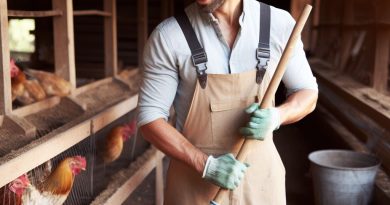Boosting Pasture Yield: Top Techniques
Last Updated on March 2, 2024
Introduction
Importance of Boosting Pasture Yield
Optimizing pasture yield is paramount for sustainable agriculture, influencing livestock nutrition, and overall farm productivity.
Overview of Top Techniques to be Discussed
Today, we’ll delve into key techniques to boost pasture yield:
- Rotational Grazing: Maximizing forage growth through strategic livestock rotation.
- Soil Fertility Management: Enhancing soil health for nutrient-rich pastures.
- Proper Forage Selection: Choosing suitable forage varieties to maximize yield.
- Irrigation Strategies: Optimal water management for consistent pasture hydration.
- Pest Control Measures: Protecting pastures from pests to ensure uninterrupted growth.
These techniques aim to empower farmers in elevating pasture yield, fostering a resilient and thriving agricultural ecosystem.
Soil Preparation
A well-prepared soil is essential for boosting pasture yield.
In this section, we will explore the importance of soil testing, fertilizer application techniques, using organic matter to improve soil health, and implementing proper drainage systems.
Importance of Soil Testing
Soil testing is a crucial step in preparing the soil for optimal pasture yield.
It provides valuable information about the current nutrient levels, pH levels, and soil composition.
By analyzing the soil, farmers can determine the exact nutrient deficiencies and make informed decisions about the appropriate fertilizer applications.
Without soil testing, farmers would rely on guesswork, which could result in inadequate or excessive fertilizer application.
This not only wastes resources but also negatively impacts the environment.
Therefore, conducting regular soil tests is vital to ensure efficient nutrient management and maximize pasture yield.
Fertilizer Application Techniques
Proper fertilizer application is key to increasing pasture yield.
Farmers should consider the specific nutrient needs of their soils and pastures.
One effective technique is using a soil test report to guide fertilizer application rates and timing.
This ensures that the nutrients are applied in the right proportions and at the right time.
Moreover, it is important to evenly distribute the fertilizer across the pasture.
Uneven application can lead to patches of stunted growth or over-fertilized regions.
Using a calibrated spreader can help distribute the fertilizer uniformly, avoiding any potential negative effects on the pasture health and yield.
Use of Organic Matter to Improve Soil Health
Incorporating organic matter into the soil is an excellent way to enhance soil health and ultimately boost pasture yield.
Organic matter improves soil structure, water-holding capacity, and nutrient retention.
It also encourages the growth of beneficial microorganisms that aid in nutrient availability.
There are several ways to add organic matter to the soil. Farmers can apply compost, manure, or cover crops.
These organic materials slowly release nutrients, providing a sustainable source of nourishment to the soil and promoting healthy pasture growth.
Regular additions of organic matter can gradually increase soil fertility and overall pasture yield.
Implementing Proper Drainage Systems
Ensuring adequate drainage is crucial for pasture health and yield.
Poorly drained soils can lead to waterlogged conditions, which negatively affect root growth and overall plant health.
Implementing proper drainage systems helps to prevent waterlogging and promotes optimal pasture development.
Farmers can install tile drains or surface drains to manage excess water effectively.
These drainage systems help remove excess water from the soil, preventing root suffocation and reducing the risk of soil erosion.
By maintaining proper soil moisture levels, pasture plants can better access nutrients and grow more vigorously, ultimately increasing pasture yield.
Therefore, soil preparation plays a significant role in boosting pasture yield.
Conducting soil testing, adopting appropriate fertilizer application techniques, incorporating organic matter, and implementing proper drainage systems are essential steps for maximizing pasture productivity.
By following these techniques, farmers can ensure healthier soils, sustainable nutrient management, and ultimately, higher pasture yields.
Read: Livestock Health: Pasture-Based Tips
Selecting the Right Seed
Understanding the different types of grasses and legumes
In order to boost pasture yield, it is essential to have a thorough understanding of the various types of grasses and legumes that can be used for seeding.
Different types of grasses and legumes have their own unique characteristics and growth patterns, which can determine their suitability for specific soil types and climate conditions.
Factors to consider when choosing seeds
When selecting seeds for pasture establishment, there are several important factors to consider.
These factors include the desired forage quality, palatability, persistence, disease resistance, and the ability to withstand grazing pressure.
- Forage quality: High-quality forage is crucial for livestock to meet their nutritional requirements. It is important to choose grasses and legumes that have good protein content and digestibility.
- Palatability: Animals need to find the forage palatable to ensure they consume an adequate amount. Some grass and legume species are more palatable to animals than others, so selecting seeds that are preferred by livestock is important.
- Persistence: Persistent grasses and legumes are able to withstand adverse conditions and maintain productive stands for several years. It is important to select seeds that have a good reputation for persistence under local conditions.
- Disease resistance: Some grass and legume species are more resistant to certain diseases than others. Incorporating disease-resistant varieties into your seed mixture is important to minimize the risk of crop failure due to diseases.
- Grazing pressure: Consider the amount of grazing pressure the pasture will experience. Some species can tolerate heavy grazing better than others, so choosing seeds that can withstand the expected grazing pressure is crucial.
Proper seed establishment and planting techniques
Once the right seed has been selected, proper establishment and planting techniques are vital to ensure successful pasture growth and maximum yield.
- Soil preparation: Prepare the soil by removing weeds, leveling the surface, and ensuring proper drainage. This helps create favorable conditions for seed germination and establishment.
- Seedbed preparation: Prepare a firm and fine seedbed to maximize seed-to-soil contact, which improves germination rates and seedling establishment.
- Seeding rate and depth: Follow the recommended seeding rate for the selected seed mixture. Plant the seeds at the appropriate depth specified for each species, ensuring good seed-to-soil contact.
- Timely planting: Plant the seeds at the optimal time for the specific grasses and legumes chosen. This ensures that the plants have enough time to establish themselves before unfavorable weather conditions occur.
- Proper fertilization: Provide the necessary nutrients to promote healthy growth and maximize pasture yield. Conduct a soil test to determine the appropriate fertilizer application rates.
- Watering and irrigation: Ensure adequate moisture during the germination and establishment period. Monitor soil moisture levels and provide irrigation if necessary to promote seed germination and seedling growth.
By understanding the different types of grasses and legumes, considering important factors when choosing seeds, and implementing proper seed establishment and planting techniques, farmers can effectively boost pasture yield and ensure healthy forage for their livestock.
Read: Essential Equipment for Modern Pig Farms
Rotational Grazing
Definition and Benefits of Rotational Grazing
Rotational grazing is a technique that involves dividing pasture into smaller paddocks and rotating livestock between them.
Benefits of rotational grazing
- Promotes even distribution of grazing pressure, preventing overgrazing in certain areas.
- Allows plants to rest and regrow, leading to improved pasture health and productivity.
- Reduces the risk of soil erosion and nutrient runoff, contributing to better water quality.
- Enhances biodiversity by creating habitat diversity and promoting native plant species.
- Increases carrying capacity, allowing farmers to support more livestock on the same land.
- Improves forage utilization as animals have access to fresh pasture, resulting in better weight gain.
- Reduces the reliance on chemical fertilizers and herbicides, leading to cost savings.
Designing and Managing Grazing Systems
Effective grazing systems require careful planning and management
- Analyze the size and shape of the pasture and divide it into smaller paddocks.
- Ensure each paddock’s size matches the number of animals and the desired grazing period.
- Install strong and easily moveable fencing to enable frequent rotation between paddocks.
- Provide a water source and shade in each paddock to meet the livestock’s needs.
- Monitor grazing intensity and adjust rotation frequency based on forage availability and growth rates.
- Consider the seasonality of grazing to allow forrest and regrowth during slower growing periods.
Adjusting Stocking Rates and Grazing Durations
Proper stocking rates and grazing durations are essential for successful rotational grazing:
- Assess the carrying capacity of the pasture to determine the appropriate number of animals.
- Consider livestock type, breed, age, and nutritional requirements when calculating stocking rates.
- Monitor forage growth and adjust stocking rates to avoid undergrazing or overgrazing.
- Adapt grazing durations based on forage availability and the desired rest period for each paddock.
- Implement rest periods that allow for adequate regrowth, typically ranging from 30 to 60 days.
- Regularly evaluate and adjust stocking rates and grazing durations based on pasture condition and productivity.
By implementing rotational grazing and diligently managing the system, farmers can significantly boost pasture yield and improve overall farm sustainability.
Read: AI in Livestock Farming: Opportunities & Risks

Weed and Pest Control
Controlling weeds and pests in pastures is crucial for boosting yield and maintaining healthy grazing grounds.
By identifying common weeds and pests, implementing integrated pest management techniques, applying herbicides strategically, and exploring biological control options, farmers can effectively combat these challenges.
Identifying common weeds and pests in pastures
Weeds can be detrimental to pasture yield, competing with desirable plants for space, nutrients, and sunlight.
Common types of weeds in pastures include thistles, dandelions, ragweed, and pigweed.
These invasive plants not only reduce the quality of forage but also hinder livestock’s ability to graze.
Additionally, pests such as armyworms, aphids, and rodents can cause further damage to pastures and pose a threat to the overall well-being of livestock.
Integrated pest management techniques
Integrated pest management (IPM) is a holistic approach to weed and pest control that emphasizes sustainable and environmentally friendly practices.
This technique minimizes the reliance on chemical interventions and focuses on prevention, monitoring, and management strategies.
By adopting IPM, farmers can effectively reduce pests and keep weeds under control.
Some practices commonly employed in IPM include regular monitoring to detect early signs of infestation, utilizing biological control methods, implementing cultural practices like rotation or mowing, and using chemical interventions as a last resort.
Herbicide application and timing
In situations where the weed population is particularly dense or rapidly spreading, herbicides can be a valuable tool.
However, it is crucial to select herbicides that target specific weed species while minimizing damage to desirable forage plants.
Farmers should carefully check labels and follow recommended dosage and application guidelines.
Applying herbicides during active weed growth stages ensures maximum effectiveness and reduces the likelihood of resistance development.
Timing plays a crucial role in herbicide application, as spraying during specific growth stages of the target weed yields optimal results.
Biological control options
Biological control involves the use of natural enemies to suppress weed or pest populations.
Introducing beneficial insects like ladybugs or parasitic wasps can be effective in controlling pests naturally.
These insects prey on common pasture pests, such as aphids or armyworms, reducing their numbers without the need for chemical intervention.
Farmers can also explore the use of biological agents like nematodes or bacteria, which target specific weed or pest species.
These agents offer a targeted and ecologically friendly approach to weed and pest control in pastures.
Most importantly, weed and pest control is vital for maximizing pasture yield and supporting healthy grazing practices.
By identifying common weeds and pests, implementing integrated pest management techniques, strategically applying herbicides, and exploring natural control options, farmers can effectively manage these challenges and ensure optimal grazing conditions for their livestock.
Read: Innovative Wool Shearing Equipment Update
Regular Monitoring and Maintenance
In order to boost pasture yield, it is crucial to implement regular monitoring and maintenance practices.
By doing so, farmers can ensure optimal conditions for their pastures and achieve higher productivity.
Importance of Regular Pasture Inspections
Regular pasture inspections are essential for identifying any potential issues or problems that may affect pasture yield.
These inspections allow farmers to catch and address problems early on, preventing them from escalating and reducing productivity.
Establishing a Maintenance Schedule
Creating a maintenance schedule ensures that farmers allocate sufficient time and resources to care for their pastures.
This includes tasks such as fertilizing, irrigating, and controlling weeds, which are all critical for maximizing pasture yield.
Recognizing Signs of Overgrazing and Taking Corrective Actions
Overgrazing can significantly impact pasture yield by depleting vegetation and reducing overall quality.
Farmers need to be able to recognize signs of overgrazing, such as thinning grass or bare patches, and take immediate corrective actions, such as rotational grazing or providing supplementary feed.
Managing Soil Compaction and pH Levels
Soil compaction and pH levels can directly affect pasture yield.
Compacted soil restricts root growth and nutrient uptake, while incorrect pH levels can inhibit nutrient availability.
Regular soil testing and implementing appropriate measures, such as aeration or lime application, can help maintain optimal conditions and maximize pasture yield.
In essence, regular monitoring and maintenance are vital components of boosting pasture yield.
By conducting regular inspections, establishing a maintenance schedule, addressing overgrazing, and managing soil conditions, farmers can ensure healthy and productive pastures.
Water Management
Ensuring adequate water supply
Water is a crucial element in boosting pasture yield and maintaining healthy grazing land.
Proper water management plays a vital role in ensuring adequate water supply, implementing effective watering systems, and managing runoff and erosion.
Adequate water supply is essential for the health and productivity of pastures.
Livestock require sufficient water intake for digestion, metabolism, and overall wellbeing.
It is crucial to assess the water requirements of animals and ensure a continuous and clean water supply.
Implementing proper watering systems and techniques
Implementing proper watering systems and techniques is another key aspect of water management.
One effective way is to provide water troughs strategically placed in each pasture.
This ensures easy access for livestock to drink water, reducing the need for them to travel long distances.
Watering systems should be designed to avoid any potential contamination.
Regular monitoring, cleaning, and maintenance of troughs or tanks are necessary to prevent the growth of algae, bacteria, and other harmful substances.
This includes regular checking of water quality to ensure it is safe for animal consumption.
Installing automatic or gravity-fed watering systems can be beneficial, as they provide a constant supply of fresh water.
These systems are efficient, reduce labor, and prevent overconsumption or wastage of water.
It is important to ensure that the water flow and pressure are suitable for animals to drink comfortably.
Managing runoff and erosion
Managing runoff and erosion is crucial in maintaining healthy pastures.
Excessive water runoff can erode the soil, leading to nutrient loss and reduced productivity.
Implementing effective erosion control measures is necessary to prevent soil degradation and preserve pasture health.
One technique for managing runoff and erosion is proper pasture layout and design.
Dividing pastures into smaller paddocks with the use of fencing allows for more controlled grazing and reduces the impact of livestock on soil health.
This helps minimize soil compaction and allows vegetation to recover more quickly.
Establishing vegetative buffer strips along waterways and slopes can also effectively control runoff and erosion.
These buffer strips help filter sediments and pollutants, preventing them from entering water bodies.
Planting native grasses, legumes, or other erosion-resistant species in these areas can further enhance their effectiveness.
Implementing water diversion techniques can redirect excess water away from vulnerable areas and into suitable catchment systems.
This can include constructing diversion channels or swales to channel water flow, ensuring it is directed away from high erosion risk areas.
Regular inspection and maintenance of waterways and drainage systems are necessary to identify and address any potential issues.
This includes clearing debris, repairing erosion-prone areas, and maintaining effective vegetation cover along waterways.
In fact, effective water management is crucial for boosting pasture yield.
Ensuring adequate water supply, implementing proper watering systems and techniques, and managing runoff and erosion are key components of successful water management.
By prioritizing these practices, farmers and ranchers can promote healthy grazing lands and maximize pasture productivity.
Supplemental Feeding and Nutrition
Understanding the nutritional needs of grazing animals
When it comes to boosting pasture yield, understanding the nutritional needs of grazing animals is paramount.
Grazing animals require a balanced diet that consists of proteins, carbohydrates, minerals, vitamins, and water.
A lack of essential nutrients can lead to poor health, reduced productivity, and increased susceptibility to diseases.
To ensure optimal nutrition for grazing animals, it is important to analyze and evaluate the quality of available forage.
Working with a veterinarian or nutritionist can help determine the specific dietary requirements for different types of livestock.
Supplementing pasture diets with feed and minerals
Supplementing pasture diets with appropriate feed and minerals can enhance the nutritional content for grazing animals.
Feeds such as hay, silage, or grains can add essential nutrients that may be lacking in the forage.
Minerals, like calcium, phosphorus, and magnesium, can be provided through mineral blocks or loose mineral formulations.
Supplementing with feed and minerals ensures that animals receive a well-rounded diet for optimal growth and health.
Consulting with a nutrition specialist can help determine the right type and amount of supplementation required.
Implementing feeding strategies during different seasons
Implementing proper feeding strategies during different seasons is crucial for maximizing pasture yield.
During periods of limited forage growth, such as winter, providing supplemental feed becomes essential.
Forage testing and analysis can help identify nutritional gaps, allowing for targeted supplementation.
In summer, when pastures are abundant, animals may require fewer supplements as natural grazing meets their nutritional needs.
Adjusting the feeding strategy based on seasonal variations ensures animals receive the appropriate nutrients throughout the year.
Benefits of supplemental feeding and nutrition
Supplemental feeding and nutrition offer numerous benefits for enhancing pasture yield and animal health.
Improved nutrition leads to increased weight gain, milk production, fertility, and overall performance.
Minerals and nutrients strengthen the immune system, reducing the risk of diseases and improving animal welfare.
Supplementing with the right blend of feed and minerals can also aid in preventing deficiencies or imbalances.
Investing in supplemental feeding and nutrition ultimately maximizes productivity and supports optimal animal well-being.
Key considerations for implementing supplemental feeding and nutrition
When implementing supplemental feeding and nutrition, it is important to consider a few key factors:
- Proper analysis: Assess the nutritional value of the existing pasture before determining supplementation needs.
- Quality control: Ensure that feeds and minerals are of high quality and free from contaminants.
- Quantity and timing: Determine the appropriate amount and frequency of supplementation based on animal requirements.
- Storage and accessibility: Store feeds and minerals properly to maintain freshness and prevent spoilage.
- Monitoring and adjustments: Regularly monitor animal health, weight, and forage quality to make necessary adjustments.
Overall, understanding the nutritional needs, supplementing pasture diets, implementing feeding strategies, and considering key factors are vital for boosting pasture yield and ensuring the health and productivity of grazing animals.
Gain More Insights: Climate Impact on Pig Farming
You Might Also Like: Integrating Livestock: Poultry with Other Farm Animals
Utilizing Pasture Renovation Techniques
Reasons for renovating pastures
Pasture renovation is necessary for several reasons.
Firstly, it helps improve forage quality and quantity, ensuring sufficient nutrition for livestock.
Secondly, it enhances soil fertility and nutrient availability, supporting healthy plant growth.
Additionally, renovating pastures helps control weeds and invasive species, minimizing competition for resources.
Moreover, it increases grazing efficiency and carrying capacity, allowing for optimal livestock production.
Finally, pasture renovation promotes diversity and resilience in the pasture ecosystem, reducing the risk of disease outbreaks and improving overall ecosystem function.
Methods of overseeding and interseeding
One effective method of renovating pastures is through overseeding and interseeding.
Overseeding involves introducing desirable forage species into existing pastures to fill in bare patches and enhance productivity.
Interseeding, on the other hand, focuses on sowing additional species into established pastures to increase diversity and forage availability.
To ensure successful establishment, proper seedbed preparation, appropriate seed selection, and careful consideration of seeding rates are crucial.
Timing, soil moisture, and grazing management also play significant roles in the effectiveness of overseeding and interseeding.
Ongoing monitoring and adjustments to grazing pressure and management practices are essential for maximizing renovation success.
Implementing rotational renovation strategies
Rotational renovation strategies are another valuable approach to pasture improvement.
Dividing the pasture into smaller paddocks for rotational grazing and renovation allows for better management and control.
These smaller paddocks also enable resting periods, allowing pastures to recover and rejuvenate.
Temporary fencing can be employed to facilitate rotational grazing, preventing overgrazing in specific areas.
Implementing a planned grazing system further optimizes forage utilization and minimizes wastage.
Gradual introduction of livestock to renovated areas is important to prevent overconsumption and trampling in newly established forage.
In short, utilizing pasture renovation techniques, such as overseeding, interseeding, and rotational strategies, is crucial for maximizing pasture yield and sustainability.
These techniques address various factors affecting pasture productivity, including forage quality, soil fertility, weed control, grazing efficiency, and ecosystem diversity.
By implementing these practices, farmers and ranchers can improve their overall pasture management, ultimately leading to increased livestock production and healthier ecosystems.
Conclusion
It is evident that there are several top techniques available for boosting pasture yield.
By implementing these techniques, farmers can significantly increase the productivity and profitability of their pastures.
To recap, some of the most effective methods include regular soil testing and fertilization to ensure nutrient balance, proper grazing management to prevent overgrazing and promote regrowth, rotational grazing to optimize forage utilization, and the use of legumes and cover crops to enhance soil health and nitrogen fixation.
Additionally, utilizing modern irrigation systems, improving drainage systems, implementing effective weed and pest control strategies, and investing in pasture renovation and reseeding when necessary can also greatly contribute to higher pasture yields.
It is important for farmers to understand that these techniques require ongoing attention and monitoring, as every pasture has unique characteristics and may require customized approaches.
By keeping abreast of the latest research and seeking advice from agricultural experts, farmers can stay updated on the best practices and continue to improve their pasture management techniques.
Therefore, I strongly encourage farmers to implement these techniques on their farms.
The potential benefits are vast, including increased forage production, improved livestock performance, better soil health, and overall sustainability.
With dedication and perseverance, farmers can harness the full potential of their pastures and achieve long-term success in the agricultural industry.


